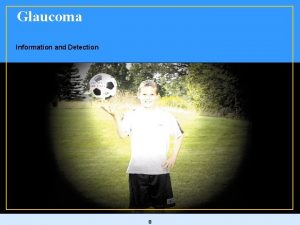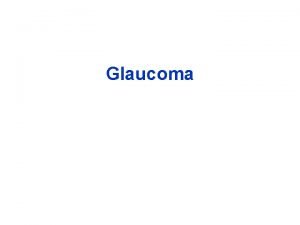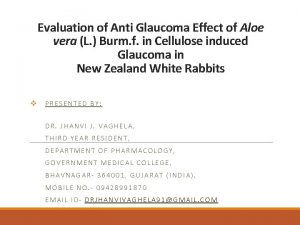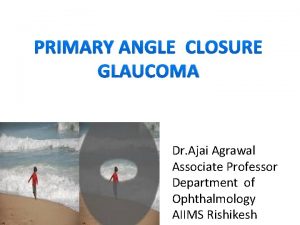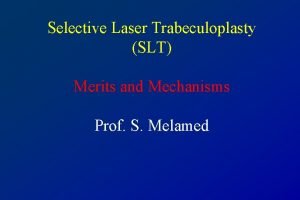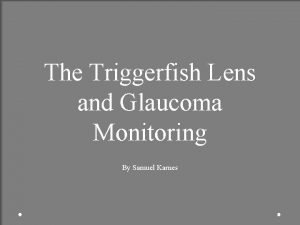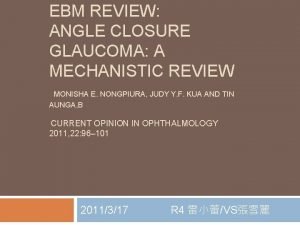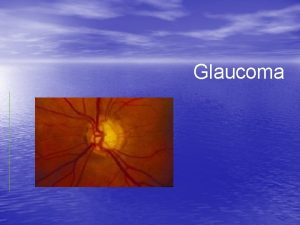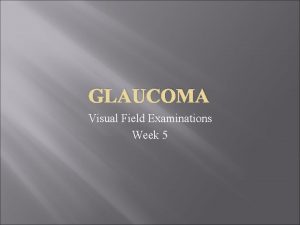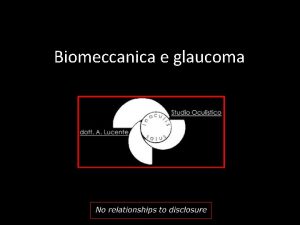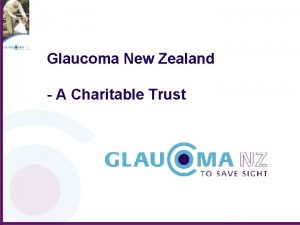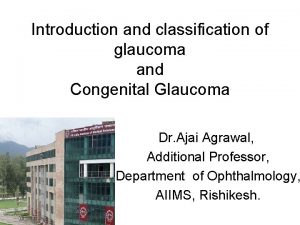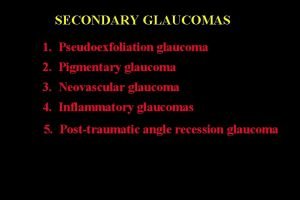Glaucoma The Sneak Thief of Sight Julie De













- Slides: 13

Glaucoma “The Sneak Thief of Sight. " Julie De. More Professor Don Williams NS 215 G

Awareness n n Glaucoma is the second leading cause of blindness in the United States and worldwide. Glaucoma affects all age groups, including infants, children, and the elderly. Most people with glaucoma are unaware they have it until there is permanent vision loss. For this reason, glaucoma needs to be diagnosed and treated as early as possible. People of African descent, relatives of people with glaucoma and people with diabetes are at a higher risk to develop glaucoma.

What is Glaucoma n Glaucoma is a serious condition that involves an elevation in pressure inside the eye caused by a build-up of excess fluid. Left untreated, this pressure can impair vision by causing irreversible damage to the optic nerve and, eventually, blindness. Glaucoma results in peripheral vision loss, and is an especially dangerous eye condition because it frequently progresses without obvious symptoms.

How the Eye Works n n n Sclera Cornea Iris Lens Retina

Symptoms of Glaucoma n At first, there are no symptoms. Vision stays normal, and there is no pain. n As the disease progresses, a person with glaucoma may notice the side vision gradually failing. That is, objects in front may still be seen clearly, but objects to the side may be missed. n As glaucoma remains untreated, people may miss objects to the side and out of the corner of their eye. Without treatment, people with glaucoma will slowly lose their peripheral side vision. Over time, straight-ahead vision may decrease until no vision remains. n Glaucoma can develop in one or both eyes.

Detecting Glaucoma n Visual acuity test. This eye chart test measures how well you see at various distances n Visual field test. This test measures your side peripheral vision. n Dilated eye exam. Drops are placed in your eyes to dilate the pupils n Tonometry. An instrument that measures the pressure inside the eye. n Pachymetry. A numbing drop is applied to your eye.

The Eye with Glaucoma n In most types of glaucoma, the eyes drainage system becomes clogged so the intraocular fluid can not drain. As the fluid builds up it causes pressure inside the eye. High pressure damages the sensitive optic nerve and results in vision lost.

Normal vision Glaucoma Vision

Types of Glaucoma Open-Angle Glaucoma: It is the most common type of glaucoma n It is caused by the slow clogging of the drainage canals, resulting in increased eye pressure. n Has a wide and open angle between the iris and the cornea n Develops slowly n Has symptoms and damage that are noticed

Angle-Closure Glaucoma: Is a less common type of glaucoma. n Is caused by blocked drainage canals, resulting in a sudden rise in intraocular pressure. n Has a closed or narrow angle between the iris and cornea. n Develops very quickly n Has symptoms and damage that are very noticeable n Demands immediate medical attention

Treating Glaucoma n Medicines. In the form of eye drops or pills, are the most common early treatment for glaucoma. Some medicines cause the eye to make less fluid. Others lower pressure by helping fluid drain from the eye. n Laser trabeculoplasty. Helps fluid drain out of the eye. Your doctor may suggest this step at any time. In many cases, you need to keep taking glaucoma drugs after this procedure. n Conventional surgery: Makes a new opening for the fluid to leave the eye. Your doctor may suggest this treatment at any time. Conventional surgery often is done after medicines and laser surgery have failed to control pressure.

Is There A Cure? n With early diagnosis and proper medications and treatment, glaucoma can be controlled. However, sight lost resulting from glaucoma can not be restored. At the present time there is not a cure. Once detected, glaucoma usually requires ongoing, long term care.

Sources n n n n http: //www. nei. nih. gov/health/glaucoma_facts. asp http: //www. aoa. org/x 4709. xml? video=x 8371&Play=true http: //www. afb. org/seniorsite. asp? Section. ID=63&Topic. ID =286&Document. ID=3198 http: //www. glaucomaweb. org/ http: //www. glaucoma. org/index. php Google Pictures http: //www. aoa. org/x 4709. xml? video=x 8370&Play=true/ video
 Conditional sentences exercises
Conditional sentences exercises Is it ok to sneak food into the movies argumentative essay
Is it ok to sneak food into the movies argumentative essay Sneak circuit analysis
Sneak circuit analysis Open angle glaucoma risk factors
Open angle glaucoma risk factors Dot
Dot Pseudoexfoliation glaucoma
Pseudoexfoliation glaucoma Laser iridotomy
Laser iridotomy Glaucoma continuum
Glaucoma continuum Capsulatomy
Capsulatomy Is aloe vera good for glaucoma
Is aloe vera good for glaucoma Root of iris
Root of iris M
M Triggerfish glaucoma
Triggerfish glaucoma Primary angle closure glaucoma
Primary angle closure glaucoma



